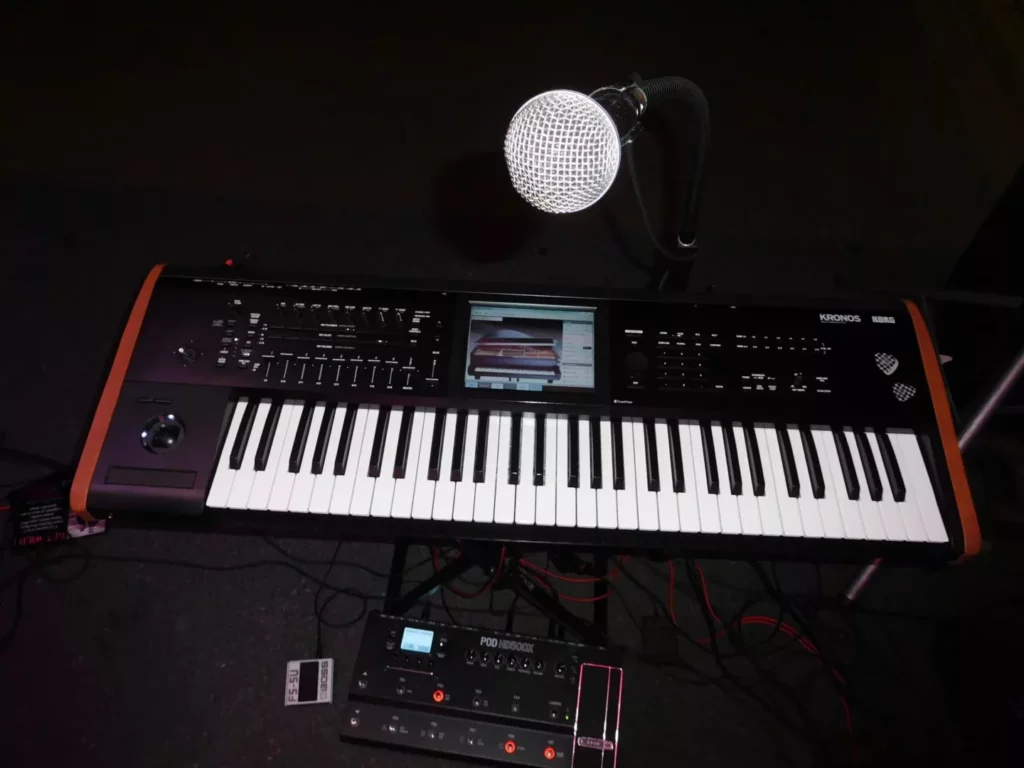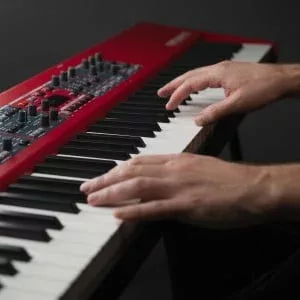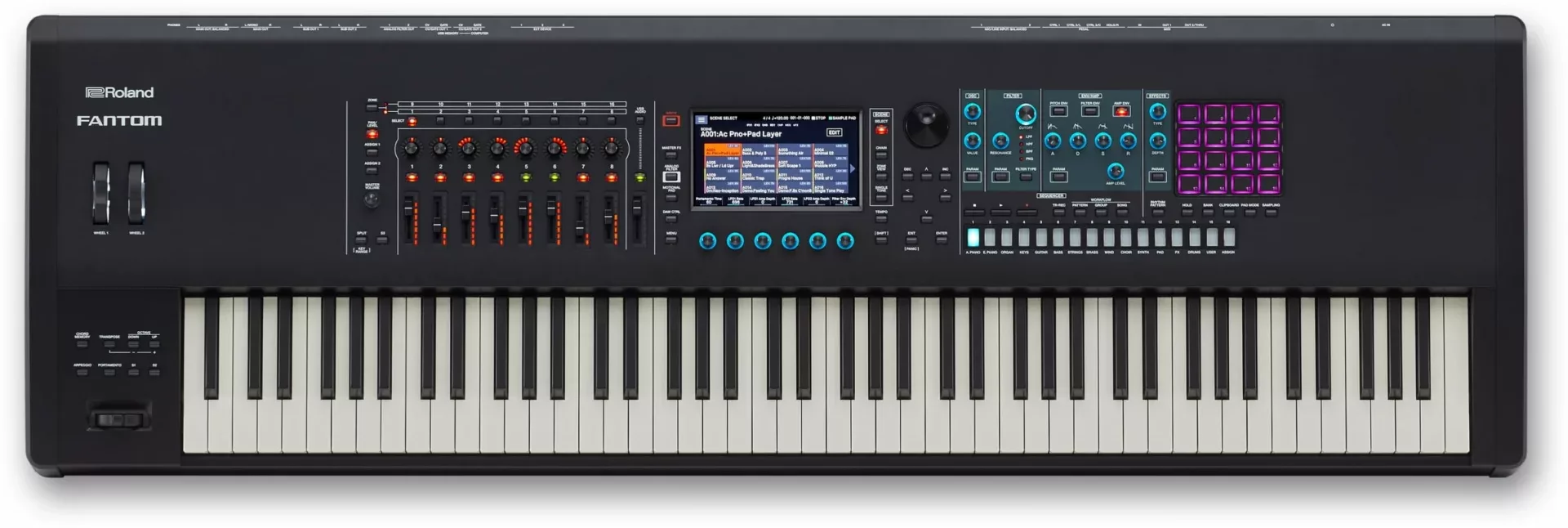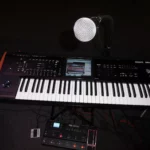
The Korg Kronos is a highly versatile and powerful music workstation that offers a wide range of features for both professional and amateur musicians, and since its release in 2011, it has dominated the workstation market.
Designed to be an all-in-one solution for composing, performing, and recording music, the Korg Kronos is still an attractive instrument for pianists in 2023.
In this review, we will examine some of the key features of the Korg Kronos and Kronos 2, and what makes them such highly regarded instruments in the world of music performance and production.
Is The Korg Kronos Still the Best Workstation in 2024?
Contents
- Is The Korg Kronos Still the Best Workstation in 2024?
No products found.
Korg Kronos: Models
There are several different models of the Korg Kronos 1 and 2. Whilst not all are available still in music stores and online shops, you may have luck on used sites such as Reverb, eBay, and FB marketplace.
If you are in the market for a Kronos and find a good deal, you should snap it up, as they are sought after and hold their value.
The pianos and EPs on the Kronos are especially good and highly usable for both recording and performance purposes. The piano sounds stand up against some of the best VST instruments available today.
Here are the different models of the Kronos to look for:
Korg Kronos 1 (88-key)

This was the piano that reinvented the wheel and redefined what was possible in a workstation piano.
With so much power underneath the hood and a wealth of impressive sound engines, samples, synths, effects, and more, the original Kronos set itself apart from the competition, and is still an excellent instrument in 2023.
The 88-key Kronos features the acclaimed RH3 weighted (and graded) keybed from Korg (also found in the Korg SV1 and SV2.
Korg Kronos 1 (73-Key)

A slightly shorter piano, but some would argue that the 73-key models are often the best in terms of practicality. Size isn’t everything it seems and the Korg Kronos proves that with the 73-key having the same RH3 weighted.
Korg Kronos 1 (63-Key)
The 63-key model is the smallest Kronos, with a different keybed (Natural Touch semi-weighted).

Korg Kronos X
The Kronos X was the first model released in 2012, and it was an updated version of the original Kronos. It comes in 61, 73, or 88-key models, has a 16-track MIDI sequencer, and has the ability to play up to 16 simultaneous sounds.
Korg Kronos 2
The Kronos 2 was released in 2015 and features several improvements over the Kronos X, including a more powerful processor, improved memory, and an enhanced touchscreen interface.
It comes in 61, 73, and 88-key models, where 61 keys will always be a semi-weighted keyboard feel, and 73 and 88-key models have the RH3 weighted keybed.
Korg Kronos LS
The Kronos LS (Light-Touch Keyboard) was released in 2017 and features a lighter, more responsive keyboard than previous models.
It comes in an 88-key semi-weighted model, and is a good option if you find the standard Kronos is too heavy, as it keeps the 88 keys but is 6.2 kg (14 lbs) lighter.
Korg Kronos SE
The Kronos SE (Special Edition) was released in 2018 and has a new red and black color finish, upgraded Italian-made grand piano sounds, and a new grand piano RH3 keybed. It comes in an 88-key version only.
All of these models feature Korg’s powerful synthesis engine and a wide range of built-in sounds, as well as the ability to load additional sound libraries and samples when purchased and downloaded from Korg.
Korg Kronos: Sound Engines

One of the standout features of the Korg Kronos is its exceptional sound quality. The instrument features nine different synthesis engines, including the highly-regarded SGX-2 piano engine, which delivers incredibly realistic piano sounds.
The Kronos also features a wide range of other high-quality sounds, including strings, brass, percussion, and more.
For piano sounds, damper resonance and mechanical noise are reproduced, and there is modeled string resonance. These effects add realism to the pianos.
The Korg Kronos is well-regarded for its exceptional sound quality and versatile sound capabilities.
The nine different sound engines, each with its own unique set of sounds and synthesis methods are each impressive in their own way. Let’s take a closer look at some of the sound engines in the Kronos:
SGX-1 and SGX-2 Premium Piano
This sound engine uses continuous (not looped) stereo piano samples sampled at eight velocity layers per key to produce a German Grand, Japanese Grand, and an optional Bösendorfer-styled Austrian Grand is available to download here.
The samples are directly streamed from the internal solid-state drive by using VMT (Virtual Memory Technology.
The SGX-2 Premium Piano superseded the SGX-1 sound engine. SGX-2 added modeled string resonance, support for soft pedal samples, and 12 velocity layers per key.
It also added a new Bechstein-styled Berlin Grand sample. This is factory-installed on the Kronos 2, and the Kronos 1 and EX models received an OS update which includes the SGX-2 engine.
SGX-2 has 100 voices. The SGX-2 engine uses detailed multi-sampling and advanced synthesis techniques to create highly detailed and expressive piano sounds.
EP-1 MDS Electric Piano
In addition to piano sounds, the Kronos also features a wide range of Rhodes electric piano sounds. The instrument includes a number of different Rhodes sound variations, including classic sounds from the 70s and 80s, as well as more modern interpretations.
The Kronos also includes a range of effects specifically designed for electric piano sounds, including phasers, wahs, and tremolos.
This sound engine offers four models based on specific classic Rhodes electric pianos and two based on Wurlitzer pianos, with software control over hammers, tines, reeds, and mechanical noise elements.
It also simulates amplifiers, cabinets, speakers, and effects associated with those historic electric pianos. This synth engine didn’t exist on the older Korg Oasys and has 104 sounds in the bank.
CX-3 Tonewheel Organ
This engine is carried over from the Korg CX-3 modeled tonewheel organ released in 2001 (not Korg’s 1980 CX-3 based on octave-divider technology).
The CX-3 engine models a classic tonewheel organ, including rotary speaker effects, vibrato and chorus effects, and a tube amplifier.
Nine hardware sliders on the Kronos’ control panel function as organ drawbar controllers. The Kronos is also capable of producing highly realistic Hammond organ sounds thanks to this engine.
The instrument also includes a number of other organ sounds, including pipe organ and transistor organ sounds.
The organ sounds on the Kronos are highly customizable, with a range of effects and parameter adjustments available to tweak the sound to your liking.
A significant upgrade to this engine was made in November 2013 with OS 2.1 which improved both the organ model and the Leslie speaker simulation and was accompanied by two extra banks of organ patches.
HD1 High Definition Synthesizer
This uses sample-based synthesis and wave sequencing to generate sounds. There are 140 sounds in the HD1 program.
MS-20EX Legacy Analog Collection
Models an expanded version of the original Korg MS-20 semi-modular monophonic analog synthesizer originally released in 1978.
This engine is basically an update to the version released by Korg in their “Legacy Collection” software. It is also found on Korg Oasys as part of the LAC-1 engine. It has 40 voices in total.
PolysixEX Legacy Analog Collection
This engine models an expanded version of the 6-voice Korg Polysix analog synthesizer produced by Korg from 1982-3.
Similar to the MS-20EX, this engine is also an update to the version in Korg’s “Legacy Collection” software and can also be found on the Korg Oasys as part of the LAC-1 engine. It has 180 separate sounds.
AL-1 Analog Synthesizer
Models analog subtractive synthesis, with a range of modeled oscillator waveforms, filters, hard sync, analog-style FM, and ring modulation.
This is another sound engine passed down from the older Korg Oasys which the Kronos replaced. It has 80 separate sounds. AL-1 has 80 voices.
MOD-7 Waveshaping VPM Synthesizer
is capable of classic FM sounds and has import compatibility with Yamaha DX7 SysEx formatted sounds.
The MOD-7 engine also combines Variable Phase Modulation (VPM), waveshaping, ring modulation, samples, subtractive synthesis, and modular patching.
These effects create a wider range of sounds than would have been possible on a classic Yamaha DX-series synthesizer. The Mod-7 synth engine has MOD 52 voices in total.
STR-1 Plucked Strings
Creates sounds derived from the physical properties of struck or plucked string sounds.
This sound engine is well-suited for creating sounds like guitar, harpsichord, clavinet, harp, and bell sounds, as well as other sounds based on the physics of a plucked string but not directly related to any known instrument. The STR-1 has 40 separate sounds.
Korg Kronos: Effects
Additionally, the Kronos has a large number of onboard effects, which add to the quality of the music that you can produce on the instrument. The user interface is intuitive and simple.
Once you have spent some time with this instrument, you will quickly learn how to add these effects to your sounds.
Also, if you are ever even slightly lost Korg has a YouTube channel dedicated to explaining how their instruments work in detail, including the Kronos and the Nautilus.
The Kronos has 12 different Insert Effects, 2 Stereo In and Stereo Out Master Effects, Timbre EQ, Dynamic Modulation, Common LFO Effects, Stereo side-chaining for compressors, gates, vocoders, and more.
Korg Kronos: Synth Sounds

One of the standout features of the Korg Kronos is its powerful synthesis capabilities.
The Kronos includes a number of different synth sound engines, including the AL-1 engine, which is a highly capable virtual analog engine, and the MOD-7 engine, which is a highly flexible FM synthesis engine.
Additionally, the Kronos includes a number of other synthesis methods, including physical modeling and wavetable synthesis.
The range of synth sounds available on the Kronos is vast, with everything from classic analog synth sounds to modern digital soundscapes. This Korg instrument is therefore extremely versatile and caters to piano, electric piano, organ, and synth players.
Korg Kronos: Sequencer and Set List
The 16-track sequencer is highly useful in the Kronos and essentially allows you to compose and record entire songs without using a computer or DAW software, as it has a 16-track hard disk recorder and 1 master track, as well as the sequencer.
The sequencer on the Kronos is still a stand-out feature, due to its intuitive design and usability. The sequencer and the 9 separate sound engines, help to set the Kronos apart from other pianos such as the Nords, Yamahas, and Rolands.
There is even a handy set list function that allows performers to easily set up their Kronos for their full performance with different programs and sounds.
- 128 set lists, 128 slots per setlist
- Each set list provides a 9-band graphic EQ and a Tone Adjust function that allows program settings to be adjusted.
- Transpose setting.
- Hold Time setting of Smooth Sound Transition (SST) supported for each slot
Korg Kronos: Design and Build Quality
The Korg Kronos has a sleek and modern design that is both functional and attractive. It features a full-size keyboard with 88 weighted keys, which gives it a professional feel and allows for more expressive playing.
The build quality of the Kronos is also top-notch, with high-quality materials and attention to detail throughout, with a satisfying weight to all models, making the unit feel solid and durable. The weight of the different models is as follows:
61 key: 14.3 kg / 31.53 lbs.
73 key: 21.1 kg / 46.52 lbs.
88 key: 24.1 kg / 53.13 lbs.
Using the Korg Kronos
Despite its powerful feature set, the Korg Kronos is surprisingly easy to use. The instrument features a large, high-resolution touchscreen that provides easy access to all of its functions and settings.
Additionally, the Kronos has a number of physical controls, including knobs and sliders, that can be used to adjust parameters in real time. This makes it easy to create complex and nuanced sounds, even for musicians who are new to the instrument.
Korg Kronos: Performance
The Korg Kronos is a highly capable instrument when it comes to performance.
Its advanced sound engines allow for incredible versatility for musicians, while its professional-grade studio effects provide a wide range of options for creative expression.
Korg Kronos: Recording
The Korg Kronos is also a highly capable recording tool. It features a built-in 16-track sequencer, which can be used to create complex multi-layered compositions.
Additionally, the instrument has a large number of input and output options, including USB, MIDI, and audio, which makes it easy to integrate with other recording hardware and software.
Korg Kronos: Comparisons
Korg Kronos vs. Korg Nautilus?
No products found.
The Nautilus is similar to the Kronos from Korg, but it is a more streamlined version.
While it does not offer everything that the Kronos offers as a workstation in terms of real-time controls, it is a professional piano that operates similarly and shares a lot of the same sounds.
Unlike the Kronos, it is available in stores as new, whereas the Kronos is in most cases out of stock (and now discontinued). To see a full review of the Korg Nautilus, check out the following article:
The Korg Nautilus Full Review – The Best Workstation?
Korg Kronos vs. Nord Stage (2,3,4)

The Korg Kronos and Nord Stage are both premium pianos, but each caters to different musical needs and preferences.
The Korg Kronos is known for its extensive sound engines and the inclusion of Multi-dimensional Synthesis technology, making it a versatile choice for musicians who require a wide range of sounds and features.
On the other hand, the Nord Stage 3 is particularly favored for its performance capabilities and its focus on piano sounds, making it a preferred choice for live performances.
While the Kronos is feature-rich, the quality of the Nord Stage is often emphasized over sheer feature quantity.
This is evident in Nord Stage 3’s design, which many users find to be more thought-out and intuitive. The Nord Stage 3 also offers a better value proposition, with some users preferring it due to its design, feel, and overall user experience.
The choice between these two keyboards comes down to individual preferences, such as the need for sound customization, the importance of weight, and the specific requirements of live gigs and band performances.
The Kronos offers some things (like a sequencer) that the Nord does not, beats it in terms of internal memory and volume of sounds available, and is more of an all-in-one composition and production tool.
The Nord Stage is aimed at live performance and is more of a stage piano than a workstation, though it can function as such thanks to the extremely high-quality sounds onboard.
In my experience, even a lower-end model from Nord such as the Nord Electro 4, lasted me for many years, never failed me in live scenarios, and had more than enough high-quality sounds on board for regular function band gigs.
The Nord Stage and Korg Kronos are more professional and all-encompassing pianos, but you need to decide if you need all of their features or a more streamlined instrument.
The New Nord Stage 4 Has Arrived! (In-Depth Review)
Korg Kronos vs. Roland Fantom

The Korg Kronos and Roland Fantom are both highly regarded keyboards in the music community, each with its own set of strengths and features. The Kronos is known for its versatility, offering more sound engines compared to the Fantom.
It also boasts features such as direct sample streaming from disk, a Set List mode, and a VPiano. Some users, however, find the Kronos touchscreen to be frustrating and its menu system to be complex.
On the other hand, the Roland Fantom, especially its 2019 version, has addressed initial disappointments with updates and now features a modern user interface (UI). It is praised for its sleek UI, appealing analog filter, and user-friendly nature.
The Fantom is also favored for its synth-action keybed and its ‘always in Scene’ workflow. However, it lacks features like FM and Organ Modeling and its sequencer doesn’t have a proper timeline for audio recording synchronization.
Some users have expressed concerns about the Kronos being outdated and possibly being discontinued in the future.
In contrast, the Fantom is newer, but its unique features might require some time to get accustomed to. Ultimately, the choice between the two keyboards depends on personal sound preferences, keyboard suitability, and specific feature requirements.
If you are still debating about the ultimate workstations and stage pianos, and are not sure whether to go for a premium piano or a more basic digital model, then check out these reviews of some of the greatest pianos from Nord and Roland:
The New Nord Piano 5 review – An Upgraded Classic
Roland FP-30 vs Roland FP-30X – Best Stage Pianos? (Full Review)
Roland FP-10 review – The Best Piano for Beginners? (Yes)
Conclusion
Overall, the Korg Kronos is an exceptional instrument that delivers outstanding sound quality, ease of use, and performance capabilities.
Whether you are a professional musician looking for a powerful workstation or an amateur musician looking to take your music to the next level, the Korg Kronos is definitely worth considering.








Really Big powerfull keyboard 🎹🔥